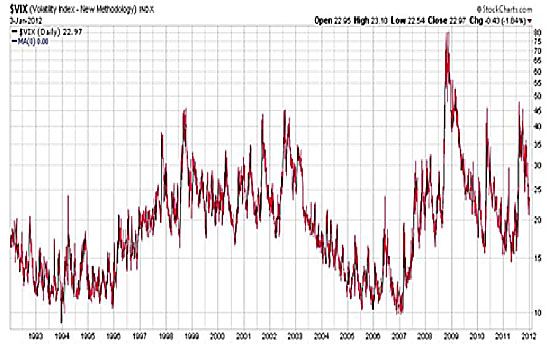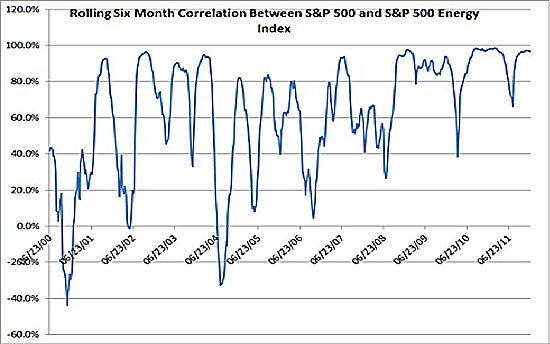Volatility is the degree to which a particular stock or index fluctuates in value over time. Many investors monitor the Chicago Board Options Exchange Index (VIX) to gauge the implied volatility of the S&P 500. Higher VIX readings suggest that traders expect market volatility to increase.

Source: Stockcharts.com
In 2011 the VIX closed between 40 and 50 on a few occasions. Although these spikes fell well short of the record high of 89 that the VIX hit at the height of the financial crisis, the volatility index’s 2011 highs were roughly on par with its peak during the 2000-2001 tech bust.
Traders use the VIX to gauge investors’ fear and often buy stocks when the VIX surges—an indication that sentiment may have bottomed. By the same token, when the volatility index remains elevated for a prolonged period, that’s often a sign that investors are worried about macro-level risks that could affect all stocks.
The VIX climbed at the end of the 21st century, when investors discovered that the fervor surrounding high-flying technology stocks had inflated expectations to unrealistic levels. The implosion of Pets.com—a company that had a successful marketing campaign but lacked a viable business plan—represents the worst of the dot-com craze. Major accounting scandals that brought down WorldCom and Enron Corp. also shook investors’ confidence.
The VIX went through the roof after Lehman Brothers declared bankruptcy and remained elevated until spring 2009, reflecting questions about the ongoing viability of the world’s leading banks and fears that the global financial system was on the verge of a complete meltdown.
Finally, the VIX spiked last summer amid concerns that the EU’s ongoing sovereignbdebt crisis would touch off a second credit crunch, akin to what happened in 2008.
Correlation, which measures how closely the prices of stocks or indexes track one another, likewise indicates the extent to which traders are focused on macro-level risks. Securities that are correlated 100% would rise or fall in lockstep, while a stock that exhibits a 30% or 50% correlation to the S&P 500 would exhibit more independence in its movements.
Savvy stock pickers thrive in periods of low or declining correlation. When stocks move in different directions, traders can reap huge gains by buying the winners and avoiding or shorting the losers. By contrast, investors have a tougher time beating the indexes when stock prices tend to move in concert because the opportunity to outperform decreases.
This graph tracks the rolling six-month correlation between the S&P 500 and the S&P 500 Energy Index from June 2000 to the end of 2011. Although the correlation between these two indexes averaged 63% over this period, this relationship tends to strengthen when investors worry about macro-level concerns.

Source: Bloomberg
The six-month rolling correlation between the S&P 500 and the S&P 500 Energy Index reached a record high of more than 92% in 2011, reflecting the prevailing risk-on/risk-off trade that’s been the subject of much discussion in the financial media.
When discouraging economic data or news from Europe weighs on investor sentiment, investors sell stocks en masse, without regard for the stock or industry’s underlying fundamentals. Conversely, in these markets, a tidbit of good news is often enough to lift even the riskiest names.
High correlation and volatility are often bad news for investors because it makes it tougher to outperform the market through savvy stock selection. In addition, heightened volatility can terrify investors, many of whom were traumatized by the market’s implosion in late 2008 and early 2009.
But volatile markets also present enormous opportunities for investors who are willing to take advantage. Here’s a quick guide to successful investing in this bipolar market.
- Heightened volatility and periods of high market correlation tend to be mean-reverting. That is, these perilous times eventually give way to periods of greater calm that rewards superior stock selection. For example, market volatility and correlations generally declined between 2004 and 2007. Timing such a shift is a fraught enterprise, but if history is any guide, we’re due for a more benign market environment at some point in 2012.
- Many energy-related stocks and industries have closely tracked moves in the broader market, but there are some noteworthy outperformers. Whereas the S&P 500 eked out a 2.1% gain in 2011, the Alerian MLP Index—a benchmark for master limited partnerships (MLP)—returned 14%. Our emphasis on MLPs, oil and gas royalty trusts and Super Oils since summer has paid off; many of our favorite names outperformed over this period.
- In volatile and highly correlated markets, investors tend to throw the baby out with the bathwater. The increasing popularity of exchange-traded funds (ETF) has contributed to this phenomenon by enabling investors to buy and sell baskets of energy-related stocks. We’ve highlighted a number of opportunities over the past several months for investors to buy high-quality stocks at substantial discounts. As panic subsides and investors focus on stock- and industry-specific stories, our favorite names should rally substantially.
- When volatility rules the tape, investors should hold a few hedges that outperform when the market dives. The model portfolio in my advisory service, The Energy Strategist, has long included a handful of short positions that target individual names and sectors that face headwinds. For example, our short position in Diamond Offshore Drilling (NYSE:DO) generated a roughly 13% gain in 2011, while we booked a 43% profit by covering our short sale of First Solar (NASDQ:FSLR), a leading producer of thin-film solar panels. These gains offset some of the losses posted by cyclical names.
- Investors can reap a quick return from shorter-term trades in volatile markets. Although The Energy Strategist usually steers clear of one- to two-day trades, we occasionally speculate on shorter-term trends. For example, our aggressive portfolio currently contains a bet on West Texas Intermediate (WTI) crude oil through US Oil Fund (NYSEArca:USO). We initiated the position on Nov. 7, 2011, and expect to close the trade for a profit in coming weeks.
Click here for a free trial of The Energy Strategist.
Elliott Gue, ETF Daily News
Elliott H. Gue is editor of Personal Finance, a one-stop source for market-beating investing advice. Gue scours the world for the best investments—whether it be growth stocks, bonds, master limited partnerships or commodities—to build and protect your wealth no matter what the "market" does. Gue delivers indepth insight and analysis that cuts through the noise and hype to reveal the truth about the economy, the market and your investments. Gue is also editor of The Energy Strategist, helping subscribers profit from oil and gas as well as leading-edge technologies like LNG, CNG, natural gas liquids and uranium stocks.
He has worked and lived in Europe for five years, where he completed a master’s degree in finance from the University of London, the highest-rated program in that field in the UK. He also received his bachelor’s of science in economics and management degree from the University of London, graduating among the top 3% of his class. Gue was the first American student to ever complete a full degree at that business school.

























































